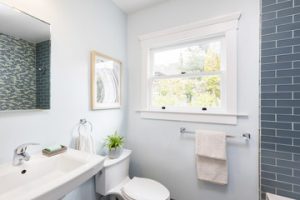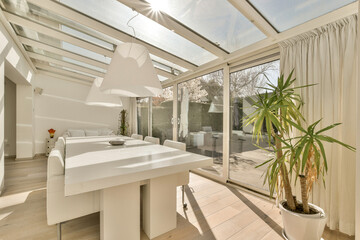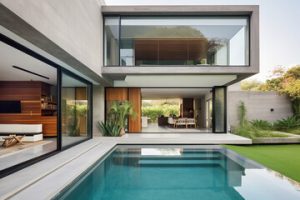Cabinet Refinishing Modesto is an excellent option for many homeowners looking to refresh their kitchen. Compared to refacing, it’s a cost-friendly and durable solution that can deliver a dramatic transformation.
A refinishing project involves a few key steps. First, the cabinets are sanded to create a smooth surface. This allows the new stain or paint to adhere properly.

Cost-Effective
Cabinet refinishing is an affordable alternative to replacing your cabinets. It is also a more environmentally friendly option. It uses existing cabinets that have already been manufactured and minimizes waste and excess materials. In addition, refinishing is less time-consuming than a full renovation. It can be completed within a few days instead of weeks or months. However, it is important to keep in mind that the quality of the job you receive will depend on the experience and skills of your contractor.
A cabinet refinishing company will use a combination of techniques to refresh your cabinetry and produce a beautiful result that will stand the test of time. This includes stripping the old finish, sanding the surface, and applying a new stain or paint. This process is suitable for wood, engineered wood, and medium-density fiberboard (MDF) cabinets. It can be done in any style, from modern to traditional. It is a great solution for homeowners who want to update their kitchen’s look without spending a fortune on new cabinets.
Unlike painting, refinishing can last for years without peeling or cracking. This is especially true if you choose a stain with high durability and moisture resistance. However, you should still perform regular inspections and touch up any areas that require attention.
Refinishing is a great alternative to remodeling if your cabinet boxes are in good condition, but you are unhappy with the color. It is a more cost-effective option than refacing, which typically costs $7,116 according to HomeAdvisor. However, refacing is not suitable for everyone, and it may not add as much value to your home as a complete remodel.
Refinishing your cabinets will not fix any structural problems, and it can’t change the layout of your space. This may mean that you will need to replace your doors and drawer fronts. Refinishing will not work for those who are planning to sell their home in the future because it is not as versatile as a complete redesign. However, it will give your kitchen a fresh look that will make it more appealing to potential buyers.
Time-Saving
Cabinet refacing is a cost-effective way to update your kitchen without completely replacing your cabinets. The process involves covering the visible parts of your existing cabinet box with a veneer, giving it a fresh new look. This is a great option for homeowners who like the layout of their kitchen but want to upgrade their cabinets’ appearance. Refacing is also a quicker option than a full renovation, saving you weeks or months of construction time.
While the difference between refacing and refinishing may seem subtle, it’s important to understand the differences before hiring a contractor for the project. A refinish job is much simpler than a refacing job and typically costs less. This is because the professional doesn’t have to remove any existing hardware or hinges or sand down the entire cabinet structure.
In addition to the cost savings, refinishing is also a more environmentally friendly choice than cabinet replacement. Refinishing uses the materials that are already in your home, reducing waste and helping to conserve resources. On the other hand, a replacement cabinet project requires a lot of new materials to be purchased and transported to your home, which contributes to waste and increases your carbon footprint.
It’s important to keep in mind that refinished surfaces need proper maintenance to ensure a long lifespan. For example, it’s best to avoid using harsh chemicals or abrasive cleaners on the surfaces. This can damage the finish and cause it to discolor or fade over time. Regular inspections of your refinished surfaces can help you catch and fix any problems before they become larger issues, such as scratches or chips.
Whether you’re looking for a quick and affordable cabinet remodel or a more complete design overhaul, there are many options available to fit your needs. If you’re ready to learn more about our cabinet refinishing services or schedule an appointment, contact us today! We would be happy to answer any questions you have and help you achieve the beautiful kitchen of your dreams.
Durable
Cabinets are the backbone of a kitchen, but they can show signs of wear and tear over time. When this happens, homeowners typically have two options: replace them or refinish them. Refinishing is a more cost-effective option and can offer dramatic results. Cabinets refinished by a professional can look new again for years to come and may even add value to the home.
When choosing a company to work on your cabinets, make sure they are experienced and use quality materials. Proper maintenance is also important to extend the life of your refinished cabinets. This includes cleaning the surface regularly with a damp cloth and avoiding harsh chemicals or abrasive cleaners.
While refinishing can provide a significant aesthetic change, it isn’t the right solution for every homeowner. If your cabinets are in poor condition or if you want to address structural issues like misaligned doors or broken drawers, cabinet refacing is a more appropriate choice.
Cabinet refacing is the process of replacing the exterior components of your cabinets, including doors and drawer fronts, with new material. It typically involves removing the existing doors and hardware from your cabinet boxes and then applying a veneer to the face frames, creating a new, fresh appearance. This can be done in a wide variety of styles and finishes.
A cabinet refacing project is more extensive than a repainting job, so it typically requires more preparation work. It often starts with sanding the surfaces to remove any rough spots and old finishes. Once this is completed, a primer can be applied to ensure the new finish adheres properly.
Then, once the primer has dried, a new coat of stain can be applied to the cabinets. This stain must be formulated specifically for the environment in which your cabinets will be used. This will help prevent moisture damage, which can cause mold and mildew, and keep the cabinets looking beautiful and new for longer. Once the stain has dried, it can be polished with a soft cloth to create a smooth, attractive finish. By following these simple steps, you can enjoy the beauty of your refinished cabinets for many years to come.
Adds Value
Refinishing is an excellent option for homeowners who are satisfied with their kitchen’s layout and configuration but want to make a fresh new appearance. It’s also an affordable alternative to cabinet replacement and refacing, and it can be used to give the entire home a modern look that appeals to buyers in today’s market. In fact, refreshed cabinets are a key selling point that can boost your home’s value by a significant margin when preparing to sell it.
Unlike refacing, cabinet refinishing is a minimally invasive process that’s completed in just a few days and can be done without disrupting your daily routine. The only elements that are replaced are the cabinet doors and drawer fronts. Because the existing cabinet boxes remain in place, there’s no need for demolition or construction dust, which makes this a much cleaner option.
Cabinet refinishing is especially good for homes with solid wood cabinets. These materials are designed to hold up well to procedures like scrubbing, cleaning, minor repairs, and refinishing, making this an affordable way to refresh their appearance and maintain their integrity for years to come. Solid wood cabinets can stand up to regular use, holidays, feasts, and everyday chaos and will retain their new look for decades with proper care.
The refinishing process starts by prepping the cabinets for a smooth finish, using medium-grit sandpaper to sand away rough spots and any old finishes that are present. Then, a new stain or fresh paint is applied to the surfaces. If the stain or paint isn’t thick enough, a top coat is then applied to add protection and longevity. The refinishing process is also eco-friendly. By reusing the existing materials, this method prevents perfectly usable materials from ending up in landfills and conserves resources by not requiring the production of new materials.
If you’re in the market to make some changes in your home’s interior, consider the benefits of a cabinet refinishing service. This is a practical, cost-efficient solution that offers a dramatic transformation at a fraction of the price of full replacement. Plus, refinishing is less invasive than a full kitchen remodel and allows for customization that you can tailor to your unique tastes and needs.





